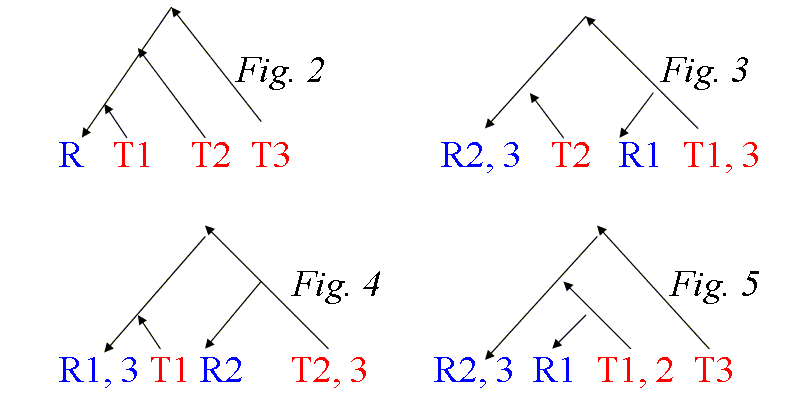XXVIIth General Assembly of URSI, Maastricht 2002
J5: Radio and Radar Studies of the Solar System. Abstract Number: 1470
UNITED SOLAR SYSTEM RADAR
IRE RAS, Vedensky Square 1, 141190, Fryazino, Russia
The main idea of the SKA concept is a hundredfold increase in collecting area, and hence in sensitivity, over existing radio astronomy facilities at metre to centimetre wavelengths. Analogously, the key idea of the USSR (United Solar System Radar) concept would be the thousandfold increase in sensitivity over existing radar astronomy facilities, and besides, only the tenfold increase in transmitting power and collecting areas of transmitting and receiving antennas is necessary for this purpose. Really, and it takes place because the radar potentiality depends on production of three above co-factors - power of transmitter and areas of transmitting and receiving antennas. Such USSR will be able to study Triton and Pluto-Charon, in contrast to early proposed bistatic configuration Arecibo (transmitter) → SKA (receiver), which has not sufficient radar potential to reach the bound of Solar System, moreover fixed Arecibo reflector can not track given celestial target more than 2.5 hours.
So, let us try to imagine the scientific impact, which would provide this United Solar System Radar. There are at least six categories of Solar System objects, which would be successfully studied with this USSR:
1) Near-Earth Objects (NEOs);
2) Long-period comets (LPCs);
3) Asteroid's moons;
4) Main belt asteroids (MBAs);
5) Moons and rings of the giant planets;
6) Pluto-Charon system.
Besides, power transmitter of the USSR would be used also in future for BETI – Broadcast to Extra-Terrestrial Intelligence, (Ostro and Sagan, 1998).
1) NEOs: There is a considerable uncertainty in long-term coordinate prediction of recently discovered NEOs. The fresh example is a heap of misinformation and confusion in the press and TV concerning impact prediction of near-Earth asteroid 2002 NT7 for February 1, 2019. But as a rule, only one delay/Doppler measurement of such new object is quite enough to increase the prediction accuracy and consequently to avoid an anxiety about forthcoming doomsday. The radar potentiality, or system factor SF, which could be enough to produce delay/Doppler astrometry of 2002 NT7 just after its discovery in July 9, 2002, when distance R was about 1 AU, is equal 4.2×1016 [W×m 5/2/K], or 166 dB. Note – the most powerful Arecibo radar has now the SF = 150 dB, only.
2) LPCs: Unlike the well-known near-Earth objects, which warning time for possible impact will be a few centuries, the same parameter for impact by new, as yet undiscovered long-period comet would be around a year. So, the human society is needed to have the powerful radar facility which will be able to detect the new LPC just after its optical discovery and to give definite answer is this new comet a threatening object or not. Only precise radar astrometry of LPC's nucleus can solve this problem with maximum possible speed, in order to avoid panic situation (Ostro, 1994). Besides, the LPC’s apparition is very rare and unexpected event and only powerful USSR-like radar can provide comprehensive scientific information about cometary nucleus and coma, because of impossibility to install and direct dedicated space probe towards this comet for such short (~ year) time interval.
3) and 4) MBAs: Regarding to MBAs, the are two significant areas for USSR activity – survey of thousands known asteroids in order to discover the small, Dactyl-like, asteroid's moons (Zaitsev, 1999), and detailed visualization and characterization of permanently growing population of known MBAs. Powerful ground-based radar is the most suitable instrument for these purposes because of impossibility for spacecraft to fly round all multitudes of MBAs.
5) Giant Planets: Jupiter's Galilean satellites revealed the variety of physical and mineralogical phenomena, as well as the bizarre radar properties (Ostro, 1999), so, it's naturally to suppose that other moons of giant planets also will appeal as a rich area of radar investigations. Besides, these targets may be used also as passive reflectors for multiple radar sounding of giant planet's rings and atmospheres during moon's eclipses.
6) Pluto-Charon system is the most distant Solar System target, and only bistatic radar configuration fits for its study, because the echo delay is about a half day. As a possible variant, we may use here the SKA as a receiver, and thus choose the site for USSR’s transmitter on the opposite than SKA side of the Earth. An estimation of needful system factor for Pluto-Charon radar research led to SF ≈ 2×1018 [W×m5/2/K], or 183 dB. Since SF is defined as
SF = Pt ´ St ´ Sr / (Ts ´ l 3/2 ),
where Pt – transmitted power, St and Sr – effective aperture of transmitting and receiving antennas, respectively, Ts – receiver system temperature, and l – radar wavelength, then for l = 3.5 cm and SKA’s (Sr/Ts) ~ 2×104 [m2/K], we get that the USSR’s production (Pt ´ St) should be about 6.54×1011 [W×m2]. Let Pt = 100 MW, then St should be 6540 m2, which can provide with one SKA-like station with single 150-m antenna, only.
In conclusion, the following intercontinental USSR configuration, with transmitting T and receiving R stations, spatial separated along 11 time zones, would be suggested (Figure 1):
Of course, four any other intercontinental USSR configurations, one – with SKA as receiver R and different, to each echelon, transmitters T1, T2, T3 (Fig. 2), and three – (two transmitters - two receivers) combinations (Fig. 3-5), are also possible for further consideration and analysis.
References
S. Ostro. In "Hazards Due to Comets and Asteroids", pp. 259-282. Arizona Press, 1994.
S. Ostro. In "Encyclopedia of the Solar System", pp. 773-807. Academic Press, 1999.
S. Ostro and C. Sagan. Cosmic Collision and Galactic Civilizations. Astronomy & Geophysics, August 1998, v. 39, Issue 4, 4.22-4.24.
A. Zaitsev, et al. Intercontinental bistatic radar observations of 6489 Golevka (1991 JX). Planetary and Space Science, vol. 45, No. 7, pp. 771-778, 1997.
A. Zaitsev. Asteroid’s Moons: Discovery by Radar. ACM 1999 Abstract Book, Ithaca, Cornell, pp. 6-7.

